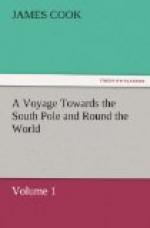Their houses are low miserable huts, constructed by setting sticks upright in the ground, at six or eight feet distance, then bending them towards each other, and tying them together at the top, forming thereby a kind of Gothic arch. The longest sticks are placed in the middle, and shorter ones each way, and a less distance asunder, by which means the building is highest and broadest in the middle, and lower and narrower towards each end. To these are tied others horizontally, and the whole is thatched over with leaves of sugar-cane. The door-way is in the middle of one side, formed like a porch, and so low and narrow, as just to admit a man to enter upon all fours. The largest house I saw was about sixty feet long, eight or nine feet high in the middle, and three or four at each end; its breadth, at these parts, was nearly equal to its height. Some have a kind of vaulted houses built with stone, and partly under ground; but I never was in one of these.
I saw no household utensils among them, except gourds, and of these but very few. They were extravagantly fond of cocoa-nut shells, more so than of any thing we could give them. They dress their victuals in the same manner as at Otaheite; that is, with hot stones in an oven or hole in the ground. The straw or tops of sugar-cane, plantain heads, &c. serve them for fuel to heat the stones. Plantains, which require but little dressing, they roast under fires of straw, dried grass, &c. and whole races of them are ripened or roasted in this manner. We frequently saw ten or a dozen, or more, such fires in one place, and most commonly in the mornings and evenings.
Not more than three or four canoes were seen on the whole island, and these very mean, and built of many pieces sewed together with small line. They are about eighteen or twenty feet long, head and stem carved or raised a little, are very narrow, and fitted with out-riggers. They do not seem capable of carrying above four persons, and are by no means fit for any distant navigation. As small and mean as these canoes were, it was a matter of wonder to us, where they got the wood to build them with; for in one of them was a board six or eight feet long, fourteen inches broad at one end, and eight at the other; whereas we did not see a stick on the island that would have made a board half this size, nor, indeed, was there another piece in the whole canoe half so big.
There are two ways by which it is possible they may have got this large wood; it might have been left here by the Spaniards, or it might have been driven on the shore of the island from some distant land. It is even possible that there may be some land in the neighbourhood, from whence they might have got it. We, however, saw no signs of any, nor could we get the least information on this head from the natives, although we tried every method we could think of to obtain it. We were almost as unfortunate in our enquiries for the proper or native name of the island; for, on comparing notes, I found we had got three different names for it, viz. Tamareki, Whyhu, and Teapy. Without pretending to say which, or whether any of them is right, I shall only observe, that the last was obtained by Oedidee, who understood their language much better than any of us, though even he understood it but very imperfectly.




